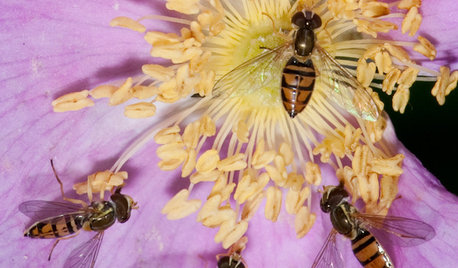Preventing/Controlling Spider Mites
Okiedawn OK Zone 7
16 years ago
Featured Answer
Comments (24)
rjj1
16 years agolast modified: 9 years agoRelated Discussions
What is the best preventative for spider mites?
Comments (1)Most insecticides that are not dedicated "miticides" only "control" spidermites, they don't eliminate them. There is a miticide available to the home gardener, its called KELTHANE. It does work, I use it, BUT....it doesn't eradicate mites like you would think it should. They will pop back out if you aren't looking, usually somewhere else on some other plant than the one you treated. I use a double-pronged technique in my greenhouse that seems to work well (and I have well over 75 plants, LOL, more like over 1500 plants). I spray infestations with Kelthane, ONCE, when I first notice them, and I spray not just the infested plant, but everything within a 2 ft radius. This is for quick knockdown. Then, a day or 2 later, I re-spray that same area and a little further out (maybe a 3-4 ft radius) with Neem Oil. This works very well for me personally. The only way to really eradicate mites, I have been told by others, is to invest in the predator mites, but that's more involved and expensive...See Morelosing the spider mite battle
Comments (34)I've been reading a lot on spider mites this week. There is another excellent thread on spider mite control here on gardenweb somewhere. The Cal Extension blog also just put out a blog about soap use on mites, and how it doesn't interrupt. I'm trying to find it. I'm with Patty on feeding plants really well -- spraying with chemicals makes me fear that I've undone all the good work souping up the the good microbes and critters in the soil. On the other hand, the Calif extension just blogged about soap use NOT interrupting the work of good arthropods, worms etc. Go figure. (Trying to find that link too.) Below is a study -- both worm castings and aerated compost tea from worm castings have reduced spider mites. SUPPRESSING PLANT PARASITIC NEMATODES AND ARTHROPOD PESTS WITH VERMICOMPOST TEAS BioCycle December 2007, Vol. 48, No. 12, p. 38 Greenhouse trials confirm that the sooner a tea is used after it is brewed, the more effective it is in influencing plant growth and suppressing diseases. Part II Clive A. Edwards, Norman Q. Arancon, Eric Emerson and Ryan Pulliam PRODUCTION and use of aqueous extracts of thermophilic composts and vermicomposts, commonly termed teas, has expanded rapidly in the last two to three years, particularly since there is now a range of commercial tea brewing equipment available that can produce large or small quantities of teas. Unfortunately, there are relatively few published scientific studies which have reviewed the methods of production and uses of compost or vermicompost teas, optimal dilutions or application rates. These teas have been used extensively, particularly by organic gardeners and farmers, to promote plant growth by application to soils as drenches, and to suppress plant diseases by soil or foliar sprays. These uses are still increasing as their methods of application and effectiveness are gradually being established. Research in our laboratory at The Ohio State University has shown clearly that some form of agitation or aeration during production of vermicompost teas is necessary, if the teas are to be effective in promoting crop growth and suppressing pests and diseases. We have research under way into the shelf-life of vermicompost teas under different temperatures and in a range of containers. We have demonstrated the transport of microbial activity and diversity, key nutrients, and enzymatic activity from solid vermicomposts into teas. Additionally, all our experience of the use of teas in greenhouse trials has confirmed that the sooner a vermicompost tea is used after it is brewed, the more effective it is in influencing plant growth and in suppressing pests and diseases. We have tested vermicompost teas extracted from vermicomposts produced from a range of animal manures such as pig or cattle wastes, as well as paper and food wastes, and all have been effective in promoting plant growth and disease suppression, independent of nutrient supply. After many laboratory and greenhouse trials, we decided that the optimal quantities of solid vermicomposts to water ratios were: 1:5 (20 percent), 1:10 (10 percent) and 1:20 (5 percent). EFFECTS OF VERMICOMPOST TEAS ON PLANT PARASITIC NEMATODES We have demonstrated clearly that solid vermicomposts can suppress plant parasitic nematodes in the field (Arancon et al. 2003). Our experiments on the effects of vermicompost teas on nematodes were in the laboratory and greenhouse, in soils that had been artificially infested with the root knot of nematode (Meloidogyne incognita), which is a very serious pest of a wide range of crops all over the world. Six-week-old tomato seedlings were transplanted into 10 cm diameter pots containing a sand and loam (1:3 ratio) soil mixture to which the test tea treatments were applied. Drench treatments of teas were applied at seedling transplanting, and every two weeks thereafter. One week after transplanting 10,000 Meloidogyne hapla eggs were added to each plant pot in suspension in tap water. The eggs were collected from cultures maintained on infested tomato plants. Each treatment was replicated four times. Pots into which tomato plants had been transplanted were arranged on benches in a completely randomized design and the greenhouse was maintained at 25°C. Plants were watered regularly with tempered line water. Thirty days after infestation with nematodes, soil was removed from the pots and the roots were washed to assess the extent of root damage and the numbers of root knots. The washed roots were rated for numbers of root knot galls and the numbers of galls per unit wet weight of roots counted. The effects of the nematodes on plant height were determined by growth measurements, including heights, leaf areas, fresh and the dry weights of leaves from plant tops and the dry weights of all above-ground tissues at the end of the experiment. The relative growth of the tomato plants in response to the nematode infestations, after 30 days, are illustrated in Figure 1. The differences in growth between treatments, in response to the vermicompost teas were spectacular, and the reductions in numbers of root knot galls on the tomato roots in response to the vermicompost tea applications was considerable (Figures 2 and 3). These effects of vermicompost teas on plant parasitic nematode attacks were very similar to those in experiments that used solid vermicompost substituted into Metro-Mix 360 in the greenhouse (Arancon et al. 2003). EFFECTS OF VERMICOMPOST TEAS ON ARTHROPOD PESTS We have shown that solid vermicomposts can suppress spider mite, mealy bug and aphid populations in the field (Arancon et al. 2007). For our preliminary experiments into the suppression of arthropod pests by vermicompost teas, we chose two important groups of plant pests, aphids and spider mites. For the spider mite experiments, four tomato plants were placed into each 0.2 mm mesh cage (40 cm x 30 cm x 30), and 100 two-spotted spider mites (Tetranychus sp.) were released into each infested cage, with four replicate cages for each treatment. The plants were treated with either water (control), aerated thermophilic 20 percent compost tea, or aerated 5 percent, 10 percent, or 20 percent vermicompost tea, produced from food waste vermicompost. The damage to the plants in these cages was assessed on a damage rating of 0 (no damage) to 5 (100 percent damage), eight days after pests were introduced into the cages. There were four replicate cages with no spider mite infestations, in order to assess any changes in leaf weights caused by the spider mite infestations. Because spider mites are so small we did not count them, instead we assessed the amounts of the distinct damage that they caused to the plants. All three soil application rates of vermicompost teas decreased the amounts of damage by the spider mites compared with the water control significantly (P < 0.05). By comparison the traditional thermophilic compost tea had no significant effect on the spider mite damage. We used the same experimental protocol in experiments on aphids. In these experiments, 100 aphids (Myzus persicae) were released onto four tomato plants, in each of the cages infected with aphids. A set of cages that had no aphid infestations was used to assess any changes in leaf weights caused by the aphids. The numbers of aphids on each plant were counted 13 days after infestation. The results are summarized in Figure 4. Clearly, all three dilutions of aerated vermicompost teas suppressed the aphid populations significantly (P < 0.05) compared with the water control treatment whereas the aerated thermophilic compost tea had no significant effects on the aphid populations. These results on the suppression of aphids and spider mites by vermicompost teas were very similar to those obtained from growing plants in the greenhouse in Metro Mix 360, substituted with a range of solid vermicomposts (Arancon et al. 2007). The suppression of aphids is particularly important since they are key vectors in the transmission of plant viruses. It seems clear that there is a good potential for suppression of arthropod pests by both vermicomposts and vermicompost teas using methods very acceptable to organic growers and farmers. The authors are in the Soil Ecology Laboratory at The Ohio State University in Columbus, Ohio. FURTHER READING Arancon, N.Q., Yardim, E., Edwards, C.A., Lee, S., 2003. The Trophic diversity of nematode communities in soils treated with vermicomposts. Pedobiologia 47, 736-740. Arancon, N.Q., Edwards, C.A., Oliver, T.J., Byrne, R.J. 2007 Suppression of two-spotted spider mite (Tetranychus urticae), mealy bugs (Pseudococcus) and aphid (Myzus persicae) populations and damage by vermicomposts. Crop Protection 26, 26-39....See MoreHow do I prevent spider mites on rosemary?
Comments (4)LMBO...prevent them, not in my world. They take something down every year-usually mums like this year-almost my tagetes lucida. I think the best thing is spraying them with water every so often. Spray during the day or morning when the plant will have time to dry so they don't turn around and get powdery mildew. People say that spider mites don't like humidity so that's why spraying helps...but they grow fine in FL which is the most humid place I've ever lived-sheesh, towels mold in the closets. This may have been luck, but I was treating some other plants for powdery mildew the other day and my marjoram had spider mites so I hit it with the same baking soda/oil/ivory dish soap solution I was using for the PM. Now the spider mites are totally gone, and I had been trying to fight them with just water. I don't know if I stumbled on something but it seemed to work better than pure water and it is the P.M. cure so maybe that would be a good idea for rosemary, I know that this mixture is fine for rosemary. You know your area best Heathen1 but her in Tx I had spider mites within the last few weeks. Here it hasn't been consistently cold enough, but they are better than during the deep summer. Oh, watch how hard you spray, I broke 1/2 a mum plant by spraying too hard. And get that rosemary outside, it will love you for it, Heathen is right....See MoreSpider Mite Control: Options and Experiences
Comments (4)No matter what you do, you are going to have to keep reapplying or respraying in order to keep spider mites under control. They reproduce at alarming rates and studies have shown that pesticides like rotenone and pyrthrin actually increase their reproduction rate. I don't have spider mite problems on my peppers but can't grow a tomato without having them all over the place. I use a soap/oil/water mix that I spray about every 7-10 days throughout the season. I find that when it is cooler out, they slow down and I can spray less. When it is really hot, I spray more often. The key to soap/oil/water mixes is keeping it constantly mixed up and only spraying at the end of the day when the sun is fully off the plants. Spray on a regular basis and you should be fine. It may not kill them all but it certainly keeps them under control and I end up with plenty of fruit at the end of the season. k...See MoreOkiedawn OK Zone 7
16 years agolast modified: 9 years agosheri_nwok
16 years agolast modified: 9 years agoOkiedawn OK Zone 7
16 years agolast modified: 9 years agoMaryl (Okla. Zone 7a)
16 years agolast modified: 9 years agosammy zone 7 Tulsa
16 years agolast modified: 9 years agoOkiedawn OK Zone 7
16 years agolast modified: 9 years agoMaryl (Okla. Zone 7a)
16 years agolast modified: 9 years agosammy zone 7 Tulsa
16 years agolast modified: 9 years agoMaryl (Okla. Zone 7a)
16 years agolast modified: 9 years agosammy zone 7 Tulsa
16 years agolast modified: 9 years agoMaryl (Okla. Zone 7a)
16 years agolast modified: 9 years agodarci60
16 years agolast modified: 9 years agoOkiedawn OK Zone 7
16 years agolast modified: 9 years agoShamae Campbell
7 years agoAmyinOwasso/zone 6b
7 years agoOkiedawn OK Zone 7
7 years agoTurbo Cat (7a)
7 years agoOkiedawn OK Zone 7
7 years agototoro z7b Md
5 years agoOkiedawn OK Zone 7
5 years agobectalk
3 years ago
Related Stories

HEALTHY HOMEWhat to Know About Controlling Dust During Remodeling
You can't eliminate dust during construction, but there are ways to contain and remove as much of it as possible
Full Story
HEALTHY HOMEWhat You Need to Know About Dust and How to Fight It
Breathe easier with these 10 tips for busting mites, dander and other microscopic undesirables
Full Story
GREEN BUILDINGBuilding Green: How to Design a Healthier Landscape
Plant selection, water management, fire-prevention measures and more can ensure that your landscape is good for the planet and for you
Full Story
GARDENING GUIDESThis Fly Is One of the Most Beneficial Insects Around
Meet the syrphid fly, a colorful pollinator that also beats chemicals for controlling aphids and other garden pests
Full Story
GARDENING GUIDESTexas Gardener: What to Do in July
Beat the heat with sun-loving blooms, pest control, good lawn care and sun protection. Pick up the pace for planting and planning
Full Story
HEALTHY HOMEHow to Keep Water Vapor From Ruining Your House and Your Health
We help you find out when it’s happening, what it means and how to fix it
Full Story
GARDENING GUIDESHow to Get Your Landscape Ready for Summer Storms
Don’t let high winds, dust storms and torrential rainfall catch you or your landscape by surprise
Full Story
EARTH DAYHow to Help Your Town’s Beneficial Birds and Bugs
Make a habitat using local materials to provide a home to the creatures that help our gardens
Full Story
EXTERIORSCare and Training for a Vine-Covered Home
Love the look but don’t want the ruin? Learn how to have vine-draped walls without all the cracks and crumbling
Full Story
GARDENING GUIDESPacific Northwest Gardener's August Checklist
Deadheading perennials, cutting raspberry canes and preparing for the onion harvest keeps Northwest gardeners busy in August
Full Story



pistol